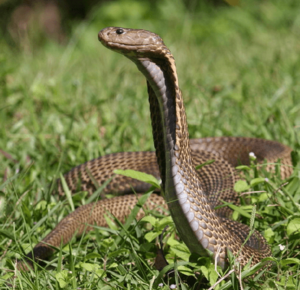Philippine cobra facts for kids
Quick facts for kids Philippine cobra |
|
|---|---|
 |
|
| Conservation status | |
| Scientific classification | |
| Genus: |
Naja
|
| Species: |
philippinensis
|
 |
|
| Distribution of the Philippine cobra | |
The Philippine cobra (Naja philippinensis) is also known as the Philippine spitting cobra. It is a strong and very venomous snake. This cobra lives in the northern parts of the Philippines. People in the Philippines call it ulupong in Tagalog and carasaen in Ilocano.
Contents
About the Philippine Cobra
The Philippine cobra was first described by an American scientist named Edward Harrison Taylor in 1922. The name Naja comes from an old Sanskrit word, nāgá, which means "cobra." The second part of its name, philippinensis, means "from the Philippine Islands."
What Does It Look Like?
The Philippine cobra is a medium-sized, strong snake. It can spread its neck ribs to form a wide hood when it feels threatened. This makes it look bigger and more scary.
Most Philippine cobras are about 1.0 metre (3.3 ft) long. Some can grow up to 1.6 metres (5.2 ft). There are stories of cobras from Mindoro Island reaching 2 metres (6.6 ft), but these are not confirmed. If true, such a length would be very rare.
The snake's head is flat and slightly wider than its neck. It has a short, round snout and big nostrils. Its eyes are a normal size with dark brown, round pupils. Adult cobras are usually light to medium brown. Young cobras are often a darker brown color.
Where Does It Live?
The Philippine cobra mainly lives in the northern parts of the Philippines. You can find them on islands like Luzon, Mindoro, Catanduanes, and Masbate. It might live on other nearby islands too, but this is not yet confirmed.
These cobras like to live in flat, open areas and forests. They can be found in grasslands, thick jungles, farms, and even near human homes. They really like water, so you often see them close to ponds, rivers, or big puddles.
What Does It Eat?
The Philippine cobra mainly eats small animals. Its favorite foods are small rodents like mice and small rats. These make up most of its diet.
However, it will also eat other snakes, small lizards, frogs, and eggs. If it gets the chance, it will even eat small birds.
Who Are Its Predators?
The Philippine cobra has several enemies. Humans are one of them. Other predators include birds of prey, the huge king cobra, and the mongoose.
Sometimes, large rats that have been bitten by the cobra might fight back. Even though the rat will eventually die from the venom, it can sometimes hurt the snake badly. Rats have been known to scratch, bite, or even poke out the cobra's eyes. This can leave the snake blind or cause serious infections.
Understanding Its Venom
The Philippine cobra has one of the most powerful venoms among all cobra species. Its venom is a strong neurotoxin. This means it mainly affects the nervous system.
The venom stops nerve signals from reaching the muscles. This can cause problems with breathing and even lead to paralysis. Unlike some other snake venoms, the Philippine cobra's venom does not usually cause much damage to the skin or heart.
These cobras are amazing because they can spit their venom! They can aim their venom accurately at a target up to 3 metres (9.8 ft) away.
If someone is bitten by a Philippine cobra, they might feel a headache, nausea, or stomach pain. They could also have diarrhea, feel dizzy, or have trouble breathing. Often, there is not much swelling where the bite happened.
In one study, many people bitten by this cobra quickly had trouble breathing. Some even stopped breathing within 30 minutes. This shows how fast and serious the venom can be. It is very important to get medical help right away if someone is bitten by a Philippine cobra.


